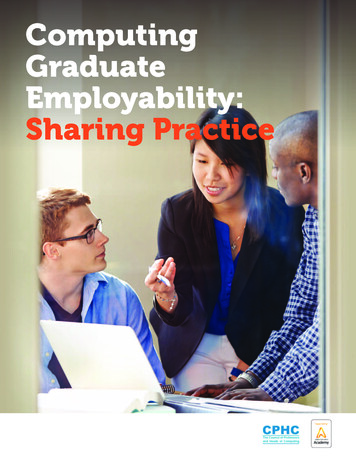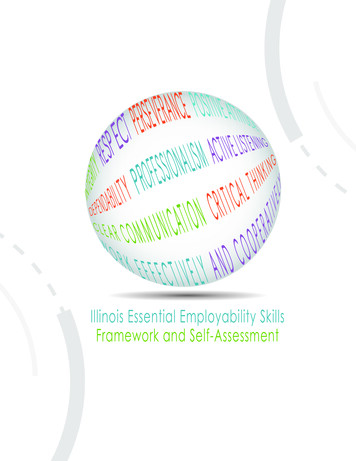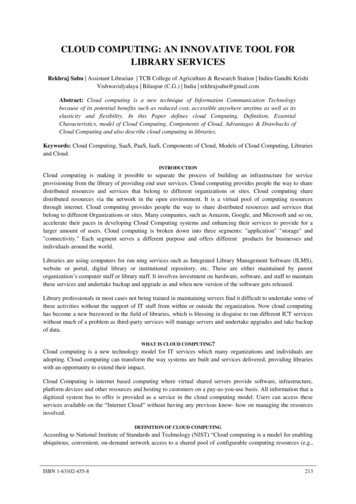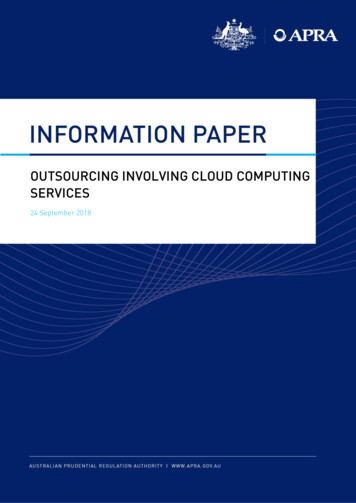
Transcription
ComputingGraduateEmployability:Sharing Practice
ContentsExecutive Summary2Introduction5Theme 1: Addressing Employability9PrologueChallenge of the Employability AgendaShowcase: Auditing (York)Challenge of Student EngagementClusters: HackathonsMentoringCompulsionShowcase: Transitions (Brunel)Showcase: ThinkFuture (Napier)Theme 2: Curriculum Issues31PrologueChallenge of Curriculum DesignClusters: Employer-led curriculumIndustry-focused projectsTheme 3: Placements45PrologueChallenge of Reaching the Tipping PointCluster:Practices across the Placement Lifecycle Preparation Application Monitoring/visits Re-entry, de-brief AssessmentShowcase: Dedicated support (Kent)Challenge of alternative modelsClusters: Placement alternativesShowcase: Short Placement module (UWS)Showcase: Multiple Engagement (South Bank)Showcase: All Summer Placements (Southampton)Employers Views85
2Computing Graduate Employability: Sharing PracticeExecutiveSummaryComputing is one of the largest subject areas in HigherEducation, and is taught in almost every institution, graduatingaround 9,000 students every year. Yet Computing graduates arerecorded as having the highest unemployment rates for allsubjects, six months after graduation: although the numbers ofunemployed graduates at six months varies widely betweeninstitutions, from 2% to 26%.The aims of this report are to expose the depth, complexity and richness of employabilitypractices in the sector, and to share those practices more widely. The report placespractices in a comparative context so that departments may learn “what works” fromeach other. It draws on research gathered from over fifty Higher Education institutions ina series of workshops, focus groups and interviews. It is never easy to find a way ofpresenting such detailed and complex data. We have chosen to foreground participants’voices and to organise the report by the common employability challenges thatacademics face. Within that structure, we present clusters of similar practice thatappear in several institutions, and a series of showcases that provide rich detail ofspecific interventions.Challenge of the employability agendaA primary feature of this challenge is the lack of overall employability infrastructure;institutions respond with a mix of local and central provision. There is concomitantdifficulty in tracking students with regard to their employability activities at any givenpoint, whether they have pursued opportunities or made applications, whether theyhave engaged in the broader discipline or with professional networks. Employabilitysuccesses are often attributed to the attitudes (and abilities) of staff, part of thischallenge is maximising staff engagement.Challenge of student engagementSome students will seize, and maximise, every opportunity. Other students do not seeor prioritise the same chances, or face various competing demands that prevent themfrom doing so. In addressing this challenge, this report presents clusters of practicefrom a variety of Universities which represent a spectrum of approaches to studentengagement in regard to making employability material compulsory, in mentoringstudents and in providing relevance and motivation by encouraging students to join(or organise) competitions and hackathons.
Computing Graduate Employability: Sharing PracticeChallenge of curriculum designThe discipline of computing has grown considerably, and with technological advances,continues to expand: space within a University degree is at a premium. Almost allinstitutions solicit the involvement of industry in regard to their curriculum, and thisreport includes a variety of ways this is instantiated; most also invite accreditation fromthe professional bodies, although the value of this is debated. There is a widely heldbelief that “soft skills” are greatly in demand in Computing graduates. There is lessconsensus on whether students lack them, and whether (indeed, how) the curriculumshould provide them. In many institutions, the fact that computing needs more provisionthan standard PCs and normal seminar rooms is a problematic limitation. Resourcingaffects the curriculum not only in matters of delivery but also in the limits it places onwhat can be taught – and especially what can be taught with “industry-strength” tools.Challenge of reaching Tipping PointFor most institutions, graduate employment is closely associated with students havinghad some industrial experience as an undergraduate. The year-long industrial placementis still considered to be a cornerstone employability practice, the best way for studentsto gain essential work experience. Wherever a placement scheme is in place, a universalmarker for success is how many students take up the opportunity, and reaching theTipping Point, where more students go on placement than do not, is aspirational. Thereport presents a collection of practices that support engagement and delivery acrossthe placement lifecycle, from preparation to assessment.Challenge of finding alternative models to the “sandwich” yearWhen it is impractical for a student to do a placement year, they risk graduating withno industrial experience at all. Given that placement is associated with better academicperformance and increased confidence and professionalism, this is problematic. Thereport presents a spectrum of possible alternatives to a whole year placement, andshowcases three institutions with different approachesA view from employersThe report concludes with a series of interviews from a small number of employers,but representative of a wide range: four large-scale corporations Network Rail, LloydsBanking Group, IBM, and HP. Two SME employers Ideaworks and Kinetic Solutions,and ectalent, a company specialising in providing one-year undergraduate studentplacements in high-technology companies in the United States.3
4Computing Graduate Employability: Sharing PracticeThese companies are all proactively engaged with a few Universities where they havefound a willing response; almost all have also had negative experiences in trying towork with some institutions. They all select students (for placement, as graduatesor apprenticeships) for both technical skills and soft skills, to ensure fit with therequirements of the role and with the company environment. Regardless of size, they allhave significant development and mentoring support for interns and graduate recruitsand invest in placement and intern opportunities as a saving on recruitment costs.ShowcasesAs well as aggregate data, this report presents showcases of employability practicesfrom seven institutions.Auditing employability: University of YorkHighlights a particularly proactive response to the key issue of keeping track ofstudent’s employment applications and status.Dedicated placement support: University of KentHighlights an approach to supporting the whole placement lifecycle, and how this hasenabled the Department to meet the challenge of reaching Tipping Point.Multiplicity of opportunities: London South Bank UniversityDetails one Department’s response to the challenge of providing alternative authenticwork-based experience, by offering students a wide range of opportunities to suitdifferent needs.Short placement modules: University of the West of ScotlandDescribes how authentic work experience is situated within the curriculum, with aparticular focus on building confidence and professionalism.Think Future: Edinburgh Napier UniversityThis Showcase addresses the issue of competing demands for students engaging withthe employability agenda by replacing the normal timetable with employability eventsand motivating students to engage through personalised pathways and relevantinteractions.Summer internships: University of SouthamptonThis is a response to the challenge of finding an alternative to the full year placement,with particular focus on the twin issues of ensuring students graduate with strong workexperience and on building relationships with employers.Transition Week: Brunel University LondonAn approach that addresses the key issues of relevance and motivation with regard tothe employability agenda, enabling students to see how employability and placement fitsinto their own university career.
Computing Graduate Employability: Sharing PracticeIntroductionThe ProjectComputing is one of the largest subject areas in UK higher education, and is taught in almost everyinstitution, graduating around 9,000 students every year. Yet in 2015, and for several years before,computing graduates are recorded as having the highest unemployment rates for all subjects, sixmonths after graduation. This is of concern throughout the sector and this report is one of a numberof responses. The Department for Business, Innovation and Skills (BIS) has commissioned an independentreview, chaired by Sir Nigel Shadbolt, to look at the accreditation arrangements for computerscience degrees to ensure that they continue to be fit for the future. It will focus on the purposeand role of accreditation and how the system can support the skills requirements of employersand improve graduate employability. The Higher Education Funding Council for England (HEFCE) has contributed an analysis of theemployment data.The project that produced the material for this report was undertaken by the Learning DevelopmentGroup (LDG) of the Council of Professors and Heads of Computing (CPHC). It was co-funded bythe CPHC and the Higher Education Academy (HEA). The purpose of the project was to shareemployability practices and in pursuit of this a number of related activities were undertaken. Firstly, in conjunction with the HEA, we ran five workshops for computing departments tonetwork with, and learn from, each other. Of course, institutions are not all the same. They donot have similar intakes, missions or expectations, and they demonstrate a wide range ofapproaches to curriculum, student experience and employability. No single piece of practicerepresents “success”: everything works somewhere. Thus the goal of the workshops was todiscuss computing discipline-specific approaches to employability: to share practice whilerespecting context. We also conducted four focus groups (again, in partnership with the HEA), which includedquestions with regard to the challenges of teaching computing, and to issues of accreditationand employability. Finally, we conducted in-depth interviews at seven institutions and with seven employers.The ReportThis report is compiled from materials presented in the workshops and focus groups, and elicited inthe interviews. One of the motivations for the project was to expose the depth, complexity andrichness of practice in the sector, another was to share that practice more widely. Rather than leavethe sharing within the workshop walls and between workshop participants, we present practices herefor consideration, adaptation and use by a wider audience.The workshops were all conducted under the Chatham House Rule, and throughout this report wepreserve the anonymity which that protection affords. Where identity was significant to the practice,we returned to institutions to gather additional detail and to obtain permission to name them.Occasionally, where a quote illustrates more than one point, we have repeated extracts in differentplaces.5
6Computing Graduate Employability: Sharing PracticeThe report is split into three thematic sections: addressing employability; curriculum issues;placements. These themes emerged from the concerns of practitioners “on the ground” and fromtheir responses to employability issues in their contexts. These three areas were repeatedly talked ofas locations of employability practices.Within each section, we organise the practices in respect to the challenges that departments face,and the key issues within those. We also include clusters of practice, where we found severalinstitutions responding to the same issue in similar ways, and showcases which provide moredetail of specific interventions.This report presents a significant range of practice, and much excellent practice. It is limited in thatwe only draw on what we heard from the institutions who participated in the project. Other themesmay have emerged if we had talked with more – or different – institutions; we may have found more,and different, practices, we may have found additional excellent practices. Nevertheless, what we havelearned shows considerable value and variety in the activities that computing departments undertakein regard to employability.The material collected is irreducibly qualitative and descriptively rich, and we have chosen to preservethat richness rather than try and aggregate issues across contexts or present it in a pseudoquantitative manner “x departments did y things”. In this research, we have selected and organisedthe practices, but as much as possible have left the description in participants’ own words, preservinganecdotal details. It is easy to believe that there is such a thing as “best” practice, and that, oncefound, it can be presented to other institutions to simply “do the same thing”. However, looking fromoutside and at a single aspect of provision, the window is very narrow. There may be many reasonsby which it is “obvious” that a practice will (or won’t) work in a different context, if only the local cultureand constraints were understood, as “the specific patterns of practice adaptation will depend on thefit between the diffusing practice and the adopting organization” (Ansari, Fiss and Zajac 2010). Thedescriptions and showcase details that we provide allows that fit to be judged.A principle aim of this work is sharing: when assessing practices for potential adoption, educatorsmake judgements on many criteria, including value and feasibility, and on a trade-off betweenthese. Thus, something that delivers the same, or lower, value as current practice will be discarded.Something that is very much better than current practice (high value) might be considered even if itis difficult to instantiate in the new context (infeasible) (Nolen et al. 2009). This sort of assessment isfacilitated by rich detail. Practitioners know their own context very well, are sensitive to authenticityand nuance, and recognise similarity (or advantage) to their own practice more readily from authenticexpression than in a list of abstracted concepts (Fincher 2000; Tenenberg and Fincher 2007).Finally, there is advantage to departments setting their local employability practice against a widerange of approaches from across the sector, as the comparative context illuminates both contrastand similarity. In this way, the compilation of material presented in this report can be used to screenlocal employability practice against other institutions’ approaches in order to generate new ideas. Inother words, to use “best practices” to generate even better practices (Golden-Biddle 2013).Three Types of ContentThis report is organised in three themes, Addressing Employability, Curriculum Issues andPlacements. Inside each theme there are (up to) three different types of content.Challenges – these express issues which are common across the sector and which influence allinstitutions. For example, in working with employability at all, any department has to consider how tocreate structures to respond to the challenge of the Employability Agenda and how to involve andmotivate the interest of students in the challenge of Student Engagement. All academics should
Computing Graduate Employability: Sharing Practicerecognise these challenges and be able to identify and relate their local response to them. Materialwithin these is presented as a series of Key Issues. These are matters which commonly – thoughnot universally – arise in respect of, or as a response to, the expressed challenge.Clusters – these are collections of practice which are variations on a theme. They present aspectrum of similar activities which occur at many institutions. Words quoted in clusters are frommultiple sources and anonymised, except in a few cases where the identity of the speaker is inherentto the practice described.Showcases – a showcase is a singular example. These represent pieces of striking practice whichare unusual, or exemplary of a specific approach, or otherwise “out of the ordinary”. The materialwithin each showcase is presented to facilitate adaptation, so each is structured in the same way: Overview of the practice Context, a sketch of the department and institution, to so the practice may be understood assituated within its context. What they do, a descriptive overview of the practice. Key characteristics – aspects that are critical to the success of the intervention, or innovativein its application. Benefits – advantages that the practice affords.Words quoted are from the individual named in the Show Case, unless otherwise indicated.ReferencesAnsari, S. M., Fiss, P. C. and Zajac, E. (2010). MADE TO FIT: HOW PRACTICES VARY AS THEY DIFFUSE. Academy ofManagement Review; Acad.Manage.Rev., 35(1), 67-92.BIS (2015) Computer science degree accreditation and graduate employability: Shadbolt review – terms of reference(BIS/15/137) hadbolt-review-terms-of-reference.Fincher, S. (2000). From Transfer to Transformation: Towards a Framework for Successful Dissemination of EngineeringEducation Frontiers in Education Conference, 2000. FIE 2000. 30th Annual., pp. F4F/14-F4F/19 vol.2.Golden-Biddle, K. (2013). How to Change an Organization Without Blowing It Up. MIT Sloan Management Review, 54(2).HEFCE (2015) Unemployment among computer science graduates – what does the data ata-say/Nolen, S. B., et al. (2009). Motivation Development in Novice Teachers: The Development of Utility Filters. In: Wosnitza, M., et al. ed.Contemporary Motivation Research from Global to Local Perspectives. Hogrefe, pp. 268.Tenenberg, J. and Fincher, S. (2007). Opening the Door of the Computer Science Classroom:The Disciplinary Commons Proceedings of the 38th SIGCSE Technical Symposium on Computer Science Education.Covington, Kentucky, USA: ACM, pp. 514-518.The following institutions participated in the project:Aberystwyth University, Aston University, Birmingham City University, Brunel University London, Cardiff University, Carlisle College,Coventry University, De Montfort University, Durham University, Edge Hill University, Edinburgh Napier University, GlasgowCaledonian University, Heriot-Watt University, Keele University, Kingston University, Leeds Beckett University, Liverpool HopeUniversity, Liverpool John Moores University, London Metropolitan University, London South Bank University, LoughboroughUniversity, Manchester Metropolitan University, Middlesex University, Newcastle University, Northumbria University, OxfordBrookes University, Sheffield Hallam University, Southampton Solent University, The Open University, University of Aberdeen,University of Abertay Dundee, University of Brighton, University of Buckingham, University of Dundee, University of Edinburgh,University of Greenwich, University of Huddersfield, University of Hull, University of Kent, University of Leicester, University ofLondon Queen Mary, University of Manchester, University of Reading, University of Salford, University of St Andrews, University ofSouthampton, University of Stirling, University of Sunderland, University of Sussex, University of the West of Scotland, Universityof Ulster, University of YorkThe project was led by Professor Sally Fincher (Chair, LDG) with a steering group composed of: Sally Smith (Chair, CPHC),Dr Iain Phillips, Professor Carsten Maple and Professor Edmund Robinson, all members of the CPHC Committee. The projectemployed Dr Janet Finlay as researcher. The report was written by Sally Fincher and Janet Finlay.7
8Computing Graduate Employability: Sharing Practice
9AddressingEmployabilityPrologueThe landscape of the “employability agenda” is formed by a number of differentpressures. Some of these are external to Higher Education institutions. The pressure ofnational statistics that show the proportion of unemployed computing graduates is feltat every level. “The statistics it’s good to work from data and if we say the statisticsare correct, what they don’t do is help with diagnosis; they just say something’s goingwrong.” Neither are the statistics uniform (some institutions have excellent employmentstatistics) nor uniformly experienced. “We usually have high graduate employability inthat the ones that get jobs get graduate jobs. The problem we have is the ones whocan’t get a computing job don’t get any job at all.” However, whether students do – ordo not – get jobs when they graduate is inevitably remote from the day-to-day routine ofteaching and it can be difficult to see how to effect change. “Well, I wouldn’t want it tobe my role but if I spent 75% of my time doing this I would want to know why thingsweren’t working. If we have poor academic performance on some of our modules thenmake no mistake about it, somebody will be charged with finding an evidence base.In the meeting yesterday we were reviewing reasons why some of our programmingcourses weren’t being as successful as they were, for instance. Members of staff werebeing charged to compile reports, and gather some evidence about that. But withemployability that doesn’t happen.”In all institutions, but especially in those that that have employability as part of theirmission and where the expectation is that every student is given a placementopportunity there can be great pressure trying to place students who are academicallyweak, or who are not skilled in presenting themselves or communicating effectively.The inclusion of employment figures in KIS and their use in marketing for admissionpurposes makes these issues visible to parents and a choice point for which universitiesstudents apply to.
10Computing Graduate Employability: Sharing PracticeIt’s just a slippery concept:The Challenge of the Employability AgendaSo one of the defining issues has been the concept of employability itself.What does it mean in context?I mean, some people stress discipline-based skills, others business awarenessskills and so-called transferable soft skills, communication etc, etc. It’s just aslippery concept to try and get hold of and to explain I think. And that doesn’t helpus to sell the concept of employability within an institution to either our studentsor our staff.Key issuesData is necessary, but not sufficient Universities are used to measuring, and being measured.With employment statistics, though, what is being measured is not necessarily obvious. “Thestatistics it’s good to work from data. If we say the statistics are correct, what they don’t do ishelp with diagnosis; they just say something’s going wrong.” Neither are the statistics uniformacross the sector (employment rates vary widely between institutions), nor uniformly experienced.“We usually have high graduate employability in that the ones that get jobs get graduate jobs. Theproblem we have is the ones who can’t get a computing job don’t get any job at all.” However,whether students do – or do not – get jobs when they graduate is inevitably remote, in time and inkind, from the day-to-day routine of teaching and it can be difficult to see how to effect change.“Well, I wouldn’t want it to be my role but if I spent 75% of my time doing this I would want to knowwhy things weren’t working. If we have poor academic performance on some of our modules thenmake no mistake about it, somebody will be charged with finding an evidence base. In the meetingyesterday we were reviewing reasons why some of our programming courses weren’t being assuccessful as they were, for instance. Members of staff were being charged to compile reports,and gather some evidence about that. But with employability that doesn’t happen.”There is no employability infrastructure Universities are well-equipped to support the academicendeavour, they have well-established mechanisms for supporting teaching and learning, and formonitoring academic progression. Equally, there are strong structures for students’ collegial lifeand welfare – sports facilities, student societies, canteens and cafes. There is no equivalent set ofresources for employability, so institutions (and departments) piece together a variety of provision,some central, some sourced locally. “Another big plus, from our point of view, is that we’ve gotengaged academic staff. Coming from the Careers Centre, the engagement of academics inemployability is a real issue. And that’s not just at [our institution] I think, it’s quite common.” Inother institutions employability is managed from the department. “2007 was when I started doing it I got a call from a company asking about employing our students. That was the first time it hadhappened where it had come directly through to the department rather than going to the universitycentral careers group When I got that call I realised that actually we could begin to do thisourselves as a department.” Sometimes, however, a lack of infrastructure means that staff areworking outside of their area of knowledge or comfort. “Occasionally – I know quite a few of youare computing staff – there are computing staff that have been at the university for 30 or 40 yearsand are running sessions on assessment centres and things like that [laughter] and probablyhave slightly more limited knowledge of what’s going on.” Where responsibility is shared betweencentral and local resource, gaps can emerge. “We had a careers fair after the exams and we got an
Computing Graduate Employability: Sharing Practiceemail saying, ‘No students have signed up for this do something about it.’ I said, ‘Well, all thestudents have gone home. There’s nobody here.’” (Laughter)Knowing where they are With no administrative infrastructure, one of the key issues fordepartments with regard to employability is knowing where students are with respect to this widercontext. An intervention can be found for every point in the student lifecycle. Before they arrive “It is particularly when you think on Open Days one of the – not surprisingly– very common questions that you are asked, particularly from parents, is, ‘What are your linkswith the industry like? What are the opportunities for work placement or work experience aspart of your courses?’” Some departments have a clear answer: “ one of the things that is, Ithink, unique about us is that we have that one-to-one. When we talk to applicants and theirparents about it, that’s one of the things that they think, ‘Wow, that’s a really good thing about[this institution], is that they will give me that coaching.’ We don’t just leave our students aloneto get a placement willy-nilly”. Early start Some institutions start with internal events. “So in the first year we tried to enhancetheir enterprising skills and behaviours. We have a two week induction programme, which helpsthem with employability, enterprise, gets them connected with different services on offer at theuniversity. And also we actually do diagnostic tests. So we identify the areas that we need tosupport them while they’re with us. And then we carry on with those interventions in theclassroom.” At other institutions, external engagement is offered early. “We organise visits tocompanies and it starts from year one. It gives students the opportunity to see companies, workand see the kinds of jobs that are out there. Get to talk to the people in the companies and findout what’s important for them when they hire and what kinds of jobs and placementopportunities that companies provide.” Keeping track Some departments have systems to track students. “Everything changescontinuously and it’s only by engaging that you can keep track. It’s getting the students inand a natural part of that network in the early stages that I’m interested in. To that end, we havehere, an accreditation of academic record that goes around what the student studies.” Othersuse professional networking instrumentally, to know what the students are doing with regard toemployment. “They create the LinkedIn profile and they link into me so I know where all thestudents are. I get these updates, so I know if they’ve got what their summer job is, for example,whether they’ve got an internship or whether they’re doing something else. If they start up theirown companies – and a lot of my students are interested in web development and they starttheir own web development companies – I get an alert, so it’s really useful for me as well.” Supporting graduates after graduating Some universities provide careers support tostudents well beyond graduation. “Important for our students is the central university careersservice will support all our graduates and help them find a job up to two years after theygraduate. What’s interesting about that is almost none of the graduating students who areunemployed exploit that facility.” Alumni networks Separate from central fundraising, many institutions value the disciplinarybenefit that alumni can bring. “I think we should all be bleeding our alumni networks drybecause often these people are more than happy to come in and help in lots of different ways.”One of the ways alumni are used is to provide individual support. “I think the Alumni Network isimportant. The kind of ad-hoc mentoring that can go on which is perhaps better done informally.I think there’s value there.” The value that alumni networks represent is not time limited. “[Giveus] more details about who you are, what you’ve done and where you’ve gone. Where you’veworked, what would you be happy to give feedback on, who would you be happy to give advice11
12Computing Graduate Employability: Sharing Pract
have significant development and mentoring support for interns and graduate recruits and invest in placement and intern opportunities as a saving on recruitment costs. Showcases As well as aggregate data, this report presents showcases of employability practices from seven institutions. Auditing employability: University of York










